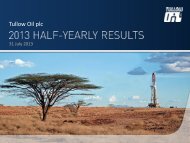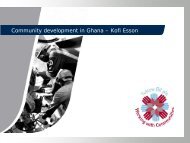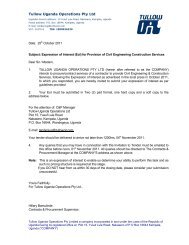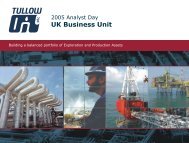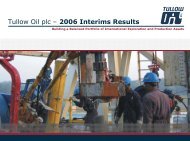2011 Annual Report PDF - Tullow Oil plc
2011 Annual Report PDF - Tullow Oil plc
2011 Annual Report PDF - Tullow Oil plc
You also want an ePaper? Increase the reach of your titles
YUMPU automatically turns print PDFs into web optimized ePapers that Google loves.
Accounting policies continued<br />
Year ended 31 December <strong>2011</strong><br />
All share-based awards of the Group are equity settled as<br />
defined by IFRS 2. The fair value of these awards has been<br />
determined at the date of grant of the award allowing for the<br />
effect of any market-based performance conditions. This fair<br />
value, adjusted by the Group’s estimate of the number of<br />
awards that will eventually vest as a result of non-market<br />
conditions, is expensed uniformly over the vesting period.<br />
The fair values were calculated using a binomial option pricing<br />
model with suitable modifications to allow for employee<br />
turnover after vesting and early exercise. Where necessary, this<br />
model was supplemented with a Monte Carlo model. The inputs<br />
to the models include: the share price at date of grant; exercise<br />
price; expected volatility; expected dividends; risk free rate of<br />
interest; and patterns of exercise of the plan participants.<br />
(w) Financial assets<br />
All financial assets are recognised and derecognised on a<br />
trade date where the purchase or sale of a financial asset is<br />
under a contract whose terms require delivery of the<br />
investment within the timeframe established by the market<br />
concerned, and are initially measured at fair value, plus<br />
transaction costs.<br />
Financial assets are classified into the following specified<br />
categories: financial assets ‘at fair value through profit or loss’<br />
(FVTPL); ‘held-to-maturity’ investments; ‘available-for-sale’<br />
(AFS) financial assets; and ‘loans and receivables’. The<br />
classification depends on the nature and purpose of the financial<br />
assets and is determined at the time of initial recognition.<br />
(x) Cash and cash equivalents<br />
Cash and cash equivalents comprise cash on hand and demand<br />
deposits and other short-term highly liquid investments that are<br />
readily convertible to a known amount of cash and are subject to<br />
an insignificant risk of changes in value.<br />
(y) Loans and receivables<br />
Trade receivables, loans and other receivables that have fixed<br />
or determinable payments that are not quoted in an active<br />
market are classified as loans and receivables. Loans and<br />
receivables are measured at amortised cost using the<br />
effective interest method, less any impairment. Interest<br />
income is recognised by applying the effective interest rate,<br />
except for short-term receivables when the recognition of<br />
interest would be immaterial.<br />
(z) Effective interest method<br />
The effective interest method is a method of calculating the<br />
amortised cost of a financial asset and of allocating interest<br />
income over the relevant period. The effective interest rate is<br />
the rate that exactly discounts estimated future cash receipts<br />
(including all fees on points paid or received that form an<br />
integral part of the effective interest rate, transaction costs<br />
and other premiums or discounts) through the expected life<br />
of the financial asset, or, where appropriate, a shorter period.<br />
Income is recognised on an effective interest basis for debt<br />
instruments other than those financial assets classified as<br />
at FVTPL. The Group chooses not to disclose the effective<br />
interest rate for debt instruments that are classified as at<br />
fair value through profit or loss.<br />
(aa) Financial liabilities and equity instruments<br />
Financial liabilities and equity instruments are classified<br />
according to the substance of the contractual arrangements<br />
entered into.<br />
(ab) Equity instruments<br />
An equity instrument is any contract that evidences a residual<br />
interest in the assets of the group after deducting all of<br />
its liabilities. Equity instruments issued by the Group are<br />
recorded at the proceeds received, net of direct issue costs.<br />
(ac) Other financial liabilities<br />
Other financial liabilities, including borrowings, are initially<br />
measured at fair value, net of transaction costs. Other financial<br />
liabilities are subsequently measured at amortised cost using<br />
the effective interest method, with interest expense recognised<br />
on an effective yield basis. The effective interest method is a<br />
method of calculating the amortised cost of a financial liability<br />
and of allocating interest expense over the relevant period.<br />
The effective interest rate is the rate that exactly discounts<br />
estimated future cash payments through the expected life of<br />
the financial liability, or, where appropriate, a shorter period.<br />
(ad) Critical accounting judgements and key sources of<br />
estimation uncertainty<br />
Details of the Group’s significant accounting judgements and<br />
critical accounting estimates are set out in these financial<br />
statements and include:<br />
Carrying value of intangible exploration and evaluation<br />
fixed assets (note 11);<br />
Where a project is sufficiently advanced the recoverability of<br />
intangible exploration assets is assessed by comparing the<br />
carrying value to internal and operator estimates of the net<br />
present value of projects. Intangible exploration assets are<br />
inherently judgemental to value and further details on the<br />
accounting policy is included in accounting note (k). The<br />
amounts for intangible exploration and evaluation assets<br />
represent active exploration projects. These amounts will<br />
be written off to the income statement as exploration costs<br />
unless commercial reserves are established or the<br />
determination process is not completed and there are<br />
no indications of impairment. The outcome of ongoing<br />
exploration, and therefore whether the carrying value of<br />
exploration and evaluation assets will ultimately be recovered,<br />
is inherently uncertain.<br />
Carrying value of property, plant and equipment (note 12);<br />
Management perform impairment tests on the Group’s<br />
property, plant and equipment assets at least annually with<br />
reference to indicators in IAS 36. Key assumptions in the<br />
impairment models relate to prices that are based on forward<br />
curves for two years and the long-term corporate assumptions<br />
thereafter and discount rates that are risked to reflect<br />
conditions specific to individual assets.<br />
122<br />
<strong>Tullow</strong> <strong>Oil</strong> <strong>plc</strong> <strong>2011</strong> <strong>Annual</strong> <strong>Report</strong> and Accounts



